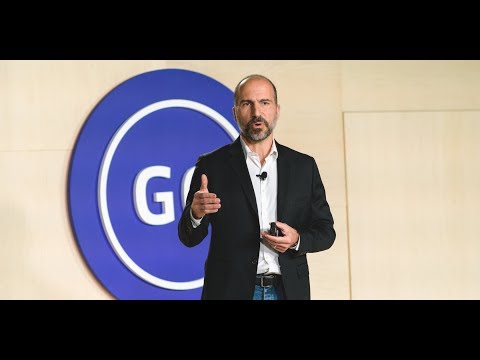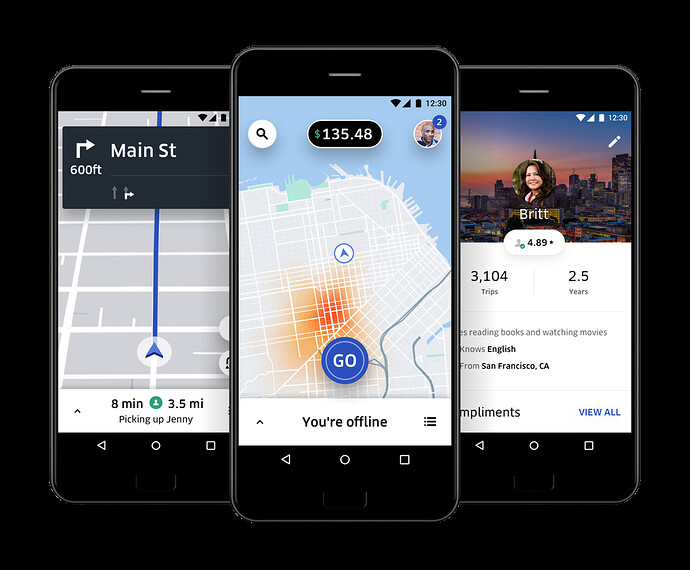After a lot of sweat, blood, and tears, Uber drivers around the world can sigh a sigh of relief. The Uber driver app has been improved completely and mainly based on driver input. The initial drive for changing the app came during the "180 days of change" that was started just when ex CEO Travis Kalanick was ousted from leading the company and was replaced a few months later by Dara Khosrowshahi.
Khosrowshahi brings a fresh approach and management flair to Uber, yet, he is still the CEO of a company that has to pay back its investors, and that means he has to improve performance and increase profitability, which is not necessarily in line with what drivers want. Having said this, there is a fine balance between what drivers can suffer in relation to their earnings and the company's profitability. This fine balance can be reached with upgrading the Uber driver app to improve the driver's experience and performance without actually changing the business model. Which is sort of a win-win situation so long as it leads to profitability., but that's another issue to deal with.
The App Team
30 engineers worked together to design the new app, under the leadership of Uber's director of Engineering Haider Sabri and Uber's Product Manager, Yuhki Yamashita. They wanted a comprehensive new approach that included solutions for both drivers and UberEats couriers, but globally, so the new changes reflect the requirements of drivers from around every market Uber is located.
Uber's Product Manager, Yuhki Yamashita and co-leader for the changes stated that "We realized that a lot of drivers don't even realize that they're on these [quests] and then they get a bonus later. They don't realize throughout that's happening because the app really doesn't put that information in the forefront. It was pretty much buried. So those are some of the areas that we want to make sure that drivers have a lot of visibility into."
The app-building team members were distributed and embedded with drivers globally, including Los Angeles; London; Melbourne, Australia; India; Bangalore, Indonesia; Jakarta, Cairo, and São Paolo, Brazil. During the development process, drivers sent WhatsApp messages to specific researchers, attend group lunches, or do test rides with the engineers using the new app.
The Uber team used Google+ (Uber's old enemy!) to discuss information and get immediate feedback from drivers and engineers working together. This resulted in a comprehensive approach that made the whole process more personalized and empowered drivers to contribute openly.
Now let's look at the app which Uber claims was "built for drivers, with drivers," rather than discuss this in a free fashion, let's look at nine of the changes:
-
Earnings Tracker
This new feature sits at the top of the screen and lets you know how much you are earning and how many trips you have completed since you went online. From here you can also gain access to "quests" and "badges" which are psychological incentives aimed at getting drivers all excited and driving for longer shifts.
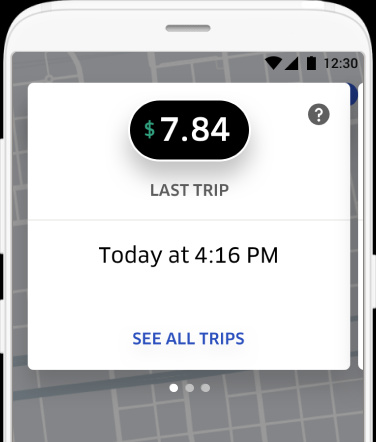
-
Quests
These are basically guaranteed with a new name; they offer the driver a cash bonus for completing a number of rides within a specific period of time.
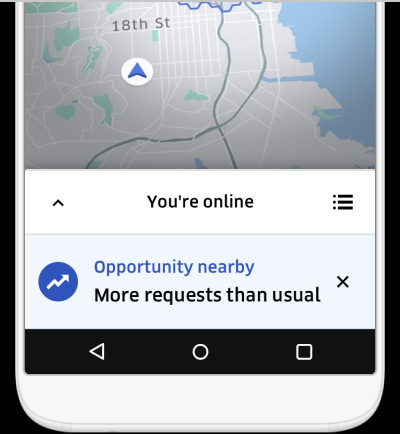
-
Badges
These are given for accomplishments, sort of like awards found in online gaming apps.
Some drivers complain that these two new features are just ways to get them to work harder shifts, while Uber claims that they are incentives that pay out money. Other drivers like the new approach and are seeking new ways to improve their shift.
-
Network Connectivity
One of the issues facing drivers in internet-less zones is connectivity during rides. The new app records the drivers GPS location at all times and will locate the drop off zone and end the trip even when the app is not in range of a network. This is mainly useful in countries with bad internet infrastructure. -
Notifications and Updates
The upgraded app includes a "feed" that prompts drivers about insurance, courses, driving classes and other localized information that is relevant to each specific driver.
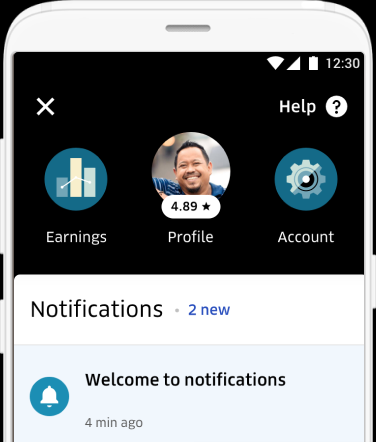
-
Ratings
The new rating page includes the riders compliments as well as the total number of trips that driver has completed ever since he/she started to work for Uber. -
Gamification
The new app is definitely gamified, taking the driving experience from the just plain old drive and get rated and tipped to drive, follow a quest, earn a badge and then get rated, reviewed and tipped. The gamification process is only put in line to urge drivers to earn more. There is a lot of transparency, but also a lot of psychology in place. -
Map vs. Surge
Another interesting change is the "heat map" that shows drivers where the action is accumulating. Rather than send messages about surge prices, the map makes life easier for Uber, and will eventually make drivers "map chasers" (which is the opposite of what is considered strategic driving.)
This map vs. surge message is a good way to help new drivers ease into the "surge pricing" issue. Most experienced drivers already know when to expect and where to expect higher paying areas. -
Request Predictor
Drivers will now get a predicted request update that will notify them when to expect the next request. For instance, 15 minutes. In that case, they could opt for driving for Lyft or another service, which would lead to a seamless shift. This new feature is quite helpful for drivers that work in less saturated areas.
38 Changes
There are 38 changes in the new Uber app; some are being applauded, others viewed with suspicion. Drivers are fickle creatures; they want to earn a lot of money without working too hard, oops, that describes 100% of humanity. So, in essence, drivers are seeking ways to improve their income and not just improve their driving experience. The only way they can improve their income is if Uber pays more. Uber will only pay more if drivers perform harder. It's a catch-22 situation and its based on the Uber, business model.
The Uber Business Model
It doesn't matter how snazzy and wow the new driver app is, the bottom line is that Uber has not changed its business model. It has merely wrapped it up in a nicer package. Drivers are still being subsidized since the passenger fee is still too low. We know this because taxi drivers went out of business and the only way a taxi driver went out of business was because they were more expensive than Uber. How is this you ask? Simple, taxis have higher minimum fare and a higher metric for a mile and minute pay. Uber undercut these prices that actually took decades to reach and cut them from underneath. What Uber basically did was take the billions from investment and transfer them to subsidies for driver income. Drivers can never earn more from Uber until Uber raises the riders to fare, stops subsidizing and builds a business model based on profit and not price war.
The Drivers Business Model
Yes, drivers have a business model too, its get in a car and drive for money. Simple, but unfortunately in many cases, generates minimum wage, and in some cases even generates losses. Drivers have to be smart, and one such driver is Los Angeles Uber Black driver Noemi Torres, a 4.96 star rated driver with over 7,000 rides, had quite a lot to say about the new changes.
Torres told the press that "Uber needs to understand that while riders are the ones paying for the service, drivers are the ones providing the service, and we are upholding our end of the deal. We, drivers, are the face of Uber, yet we are abused, underpaid, undervalued, have no health insurance, no benefits, no 401K or retirement… Yet Uber counts on the sustainability of this business model because of the unlimited number of drivers willing to work, in some cases for below minimum wage."
In regards to the new app, Torres only stated that "There are times when the app freezes and doesn't show the driver moving toward the rider, resulting in frustration and cancellations. That needs fixing."
The New Approach
Khosrowshahi explained to the press that "Drivers have lived with our tools every single day, and the insight that they bring into our app and our experience on the road is unique. We would be fools not to use their experience in helping design not just our software, but in thinking about our business."
Based on a previous study performed by Luke Stark and Alex Rosenblat back in 2016, criticized the Uber approach by statin in their paper; "Through the Uber app's design and deployment, the company produces the equivalent effects of what most reasonable observers would define as a managed labor force. At the same time, the decentralized structure of Uber's systems and their rhetorical invocation of 'platforms' and 'algorithms' may render the impression that Uber has a limited managerial role over driver behaviors." Which basically translates to state that the Uber app, even in its new form is still confusing everyone, and that drivers are still l being micromanaged by Uber.
Yamashita states that the old app was a "one-stop shop to run your business. With the old app, the attitude was: 'Here's a bunch of information organized in these four different tabs. Go find what you need."
Once the app team decided to integrate with drivers, Yamashita said abbot the drivers that "The honest answer is that they loved the idea of it, and oftentimes it was helpful for them, but we didn't always get it right. We realized that we needed to improve these features." The end product is still a one stop shop but is much more user friendly than the older version, and it will continue to undergo upgrading based on collaboration between the Uber development team and the drivers.
The new app's success is supported by Khosrowshahi, and he said that "If you optimize for your driver partners, that is a long-term winner. That is certainly our it intention with this app." In regard to income and driver earnings, Khosrowshahi said that "In general, if rates overall go up, demand goes down and if demand goes down, driver utilization goes down, and then overall earnings often go down or don't go up. There is actually very little that we can do in terms of overall earnings for drivers." When asked about the drive home pay, versus Ubers income from ridesharing, he said "If you look at the earnings of the company, I don't think you can accuse us of over-earning. Our goal is to be in a fair position, and that's what we're optimizing for."
My Take
This is a new app, it will be integrated gradually, and we will all learn to adapt. The Uber business model will only change once Uber decides to make money through profitable driving income rather then subsidize drivers. The price war is still underway, but in my opinion, if Uber and Lyft don't start to regulate their systems (limit the number of drivers per location), the over saturation will not improve their earnings, and the bottom line is that eventually, they will go bankrupt. Prices have to go up; the question is when?

